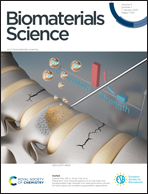Mimic enzymatic preparation of conductive supramolecular-polymeric hydrogels with antibacterial and antioxidant properties for accelerating wound healing†
Abstract
Supramolecular-polymeric hydrogels by combining low-molecular-weight gelators (LMWGs) with polymers have attracted great attention due to their unique double networks. Polymers are generally introduced into an LMWG matrix, thus enhancing the mechanical performance and broadening of the application fields of supramolecular hydrogels. Herein, a series of supramolecular-polymer hydrogels with inherent multiple properties were fabricated as wound dressings. An enzyme-like supramolecular H/G4 hydrogel co-assembled by hemin and guanosine-quartet motifs was successively integrated with hyaluronic acid (HA) and polyaniline (PANI), yielding a supramolecular-polymeric composite hydrogel (namely H/G4-HA(Cu)/PANI). The introduction of Cu2+-crosslinked hydrazide-grafted HA polymeric networks not only enhanced the viscoelasticity of the H/G4 supramolecular hydrogel but also endowed composite hydrogels with bioactive properties as wound healing dressings. The enzyme-like nanofibril H/G4 hydrogel could catalyse the oxidative polymerization of aniline, thus introducing PANI into gel networks. The porous H/G4-HA(Cu)/PANI exhibited a certain degree of swelling ratio under physiological conditions. H/G4-HA(Cu)/PANI also showed degradability, conductivity and appropriate mechanical properties. Through a full-thickness skin defect model of mice, this haemostatic, antioxidant, antibacterial and drug-free H/G4-HA(Cu)/PANI could accelerate wound healing processes by promoting wound closure, collagen deposition and upregulation of the CD31 expression level, which indicates that H/G4-HA(Cu)/PANI could be a promising wound dressing material.



 Please wait while we load your content...
Please wait while we load your content...